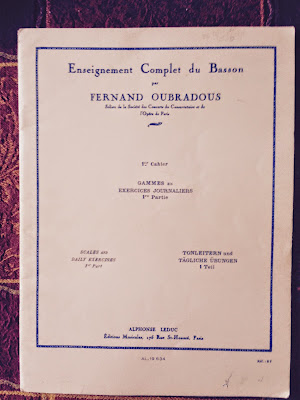Recently, a reader of this blog asked a few questions about my profile. Here are my answers and some further thoughts.
The reader asked what the measurements are that I use to set up a profiler, with specific requests for the thickness of the fold and the collar. I apologize in advance for the use of the English measurement system. The United States educational system tried to convert all of us to the metric system in the 1970's, but some stubbornness remains!
1. General thickness. I leave an average of about .03" of thickness on the profile at all points compared to a finished reed. It has been my experience that totally finishing a reed during the profile results in weaker and fewer usable reeds.
2. How to set the thickness. The thickness of the cut should be set so that the profile is thinnest (compared to measurements for a finished reed) at the intersection of the two tapers of the reed blade slope. Some call this the bump, some call it the beginning of the heart of the reed. See below where taper 1 meets taper 2.
My reed has two major tapers (I omit a small one at the very tip for simplicity's sake.) -- one that runs from the collar to about the 3/4 of the blade's length and another, sharper taper the starts there and finishes at the tip. Most German scrape reeds are similar.
Because I use a single-barrel profiler, I get only one slope for the entire length of the blade in my profile. Thus, as you can see in the diagram above, for a thin, but usable profile, it is necessary to balance the profile by bringing it as close in thickness to that of the point at which the two reed blade tapers meet.
This means that there will be some extraneous thickness at the ends (tip and collar). You can change the angle of the slope of the profile to favor a thinner collar or tip, but you must always be sure not to set the profile so that it is too thin at the crucial point in the diagram.
* Here is a clever way to avoid ruining the blade and scraping the cane barrel when adjusting the profiler thickness. Before profiling, with no cane on the cane barrel, put a shim -- made out of a piece of paper -- on the barrel , bring the blade down and pull the shim out from under the blade. If there is friction, you've probably set the profile too thin.
My profile thickness at this point is between .001-.002" greater than finished reed thickness.
2. What are my measurements for thickness at the collar and fold? I measure the collar thickness, but not the fold. Instead of the fold, I measure the thickness at the point where the tip would be cut. My shim test takes care of making sure the fold or center point of the profile is not too thin.
My collar thickness comes in at about .038" since my finished reeds end up anywhere between .032-.035" The tip profile measurement is around .015", finished being .008-.010".
To measure the profile thickness, I use my nearly endless supply of bad cane. After profiling, I remove the cane and cut it (without folding)in the two places where the two tips would be. Then I measure the thickness using a dial indicator. Measure the cane with the gouged side up for greater accuracy!
Further thoughts:
Ideally, to get a very thin tip profile, while maintaining proper thickness at the crucial point where the tapers meet, would result in an extremely thin fold, or the cutting through of the blade at the center point. That's why my profiled tip is rather heavy.
Ways around this:
- use a tip finisher after profiling.
- design a ramp for the profiler that slows or cancels the downward slope just before the center point or end of cut.
Profilers with a double taper ramp:
1. The MD Reed Products profiler has a double taper. MD will also make a profiler with my custom ramp dimensions.
2. Ramp upgrade. The PCD Company makes replacement ramps that fit the Rieger, Pfeifer and Popkin profilers. These ramps are machined with the double taper. I'm not sure about how the Rieger replacement fits on, but to add the Pfeifer or Popkin, you just unscrew the current ramp and screw the new on in place.
* In my test, the replacement ramp required almost no shimming to adjust the profile thickness, but if you try this, I would use the shim test described above to be sure the new ramp doesn't result in a profile that is too thin.
Shims made of sheet brass in different thicknesses (.003", .005", .010", etc.) can be found at a hobby store or online.





































